
Geraniales is a small order of flowering plants, included within the rosid subclade of eudicots. The largest family in the order is Geraniaceae with over 800 species. In addition, the order includes the smaller Francoaceae with about 40 species. Most Geraniales are herbaceous, but there are also shrubs and small trees.
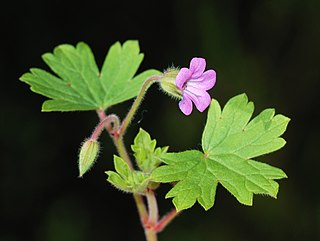
Geraniaceae is a family of flowering plants placed in the order Geraniales. The family name is derived from the genus Geranium. The family includes both the genus Geranium and the garden plants called geraniums, which modern botany classifies as genus Pelargonium, along with other related genera.
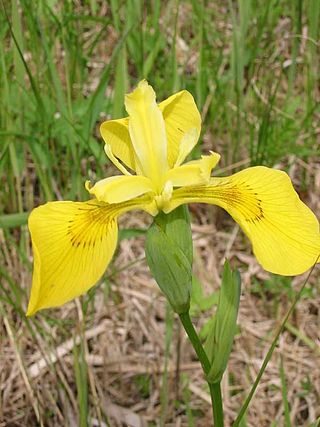
Iridaceae is a family of plants in order Asparagales, taking its name from the irises. It has a nearly global distribution, with 69 accepted genera with a total of c. 2500 species. It includes a number of economically important cultivated plants, such as species of Freesia, Gladiolus, and Crocus, as well as the crop saffron.
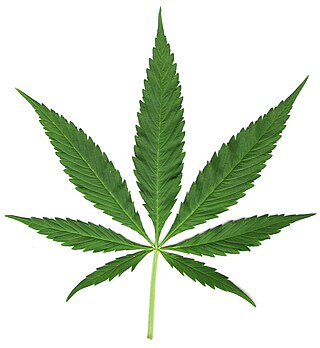
A leaflet in botany is a leaf-like part of a compound leaf. Though it resembles an entire leaf, a leaflet is not borne on a main plant stem or branch, as a leaf is, but rather on a petiole or a branch of the leaf. Compound leaves are common in many plant families and they differ widely in morphology. The two main classes of compound leaf morphology are palmate and pinnate. For example, a hemp plant has palmate compound leaves, whereas some species of Acacia have pinnate leaves.
Prof John William Heslop Harrison, FRS FRSE (1881–1967), was Professor of Botany at King's College, Durham University. He enjoyed a brilliant career, specialising in the genetics of moths, but is now best remembered for an alleged academic fraud.
Charles Dietrich Eberhard Konig or Karl Dietrich Eberhard König, KH was a German naturalist.

John Sims was an English physician and botanist. He was born in Canterbury, Kent and was subsequently educated at the Quaker school in Burford, Oxfordshire, he then went on to study medicine at Edinburgh University. Later in life he moved to London (1766) where he worked as a physician, notably he was involved with the birth of Princess Charlotte in which both mother and baby died. He was the first editor of Curtis's Botanical Magazine.

A pseudanthium is an inflorescence that resembles a flower. The word is sometimes used for other structures that are neither a true flower nor a true inflorescence. Examples of pseudanthia include flower heads, composite flowers, or capitula, which are special types of inflorescences in which anything from a small cluster to hundreds or sometimes thousands of flowers are grouped together to form a single flower-like structure. Pseudanthia take various forms. The real flowers are generally small and often greatly reduced, but the pseudanthium itself can sometimes be quite large.
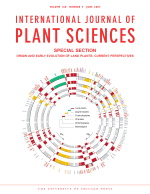
The International Journal of Plant Sciences covers botanical research including genetics and genomics, developmental and cell biology, biochemistry and physiology, morphology and structure, systematics, plant-microbe interactions, paleobotany, evolution, and ecology. The journal also regularly publishes important symposium proceedings. It is published by the University of Chicago Press. From 1875 to 1876 it was known as the Botanical Bulletin and from 1876 to 1991 as the Botanical Gazette. The first issue titled The International Journal of Plants Sciences was dated March 1992. For the years 1992 and 1993, the journal was published quarterly.

The Botanical Journal of the Linnean Society is a scientific journal publishing original papers relating to the taxonomy of all plant groups and fungi, including anatomy, biosystematics, cytology, ecology, ethnobotany, electron microscopy, morphogenesis, palaeobotany, palynology and phytochemistry.
Harvard Papers in Botany is a peer-reviewed scientific journal published twice a year, in June and December. It covers all aspects of plants and fungi including longer monographs, floristics, economic botany, and the history of botany.
The Annals of the Missouri Botanical Garden is a long-established major peer-reviewed journal of botany, established in 1914 by the Missouri Botanical Garden, under the directorship of botanist and phycologist, George Thomas Moore, and still published quarterly as of 2017 by the Missouri Botanical Garden Press. The journal is often abbreviated Ann. Missouri Bot. Gard.

The Journal of Experimental Botany (JXB) is a peer-reviewed scientific journal published by Oxford University Press on behalf of the Society for Experimental Biology. It covers research on plant biology, focusing on molecular physiology, molecular genetics, and environmental physiology. Some of its content is available under an open access licence. The editor-in-chief is John Lunn.
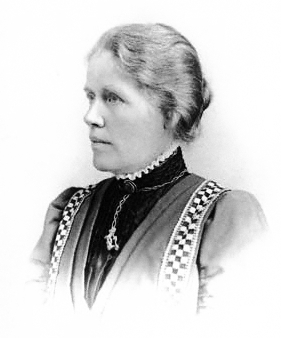
Margaret Jane Benson was an English botanist specialising in paleobotany, and one of the first female members of the Linnean Society of London. Most of her career was spent as the head of the Department of Botany at Royal Holloway College, University of London from 1893 to 1922. In 1927, a botanical laboratory was dedicated in her name. She travelled extensively with Ethel Sargant, collecting specimens, laboratory equipment, and meeting other botanists around the world. Her students included Dame Helen Gwynne-Vaughan, Theodora Lisle Prankerd, Nesta Ferguson, and Emily Mary Berridge.

Kathleen Bever Blackburn, (1892–1968) was a British botanist best remembered for the 1923 discovery that plant cells have sex chromosomes. Her principal contributions were in plant cytology and genetics. She was also a pioneer of pollen analysis. She taught botany at Armstrong College, Durham University from 1918 to 1957.
Dorothea Frances Matilda Pertz FLS was a British botanist. She co-authored five papers with Francis Darwin, Charles Darwin's son. She was made a Fellow of the Linnean Society, among the first women admitted to full membership.

AoB Plants (AoBP) is a peer-reviewed open-access, non-profit scientific journal established in 2009 and publishing on all aspects of plant biology. The editor-in-chief is Tom Buckley and the journal is published through Oxford University Press but owned and managed by the Annals of Botany Company a non-profit educational charity registered with the Charity Commission for England and Wales. AoBP was one of the first plant science journals to adopt a fully open access publishing model. An account of the thinking behind launching the journal and its progress over the first 10 years has been published. AoB Plants has two sister journals, Annals of Botany, a subscription-based general botanical journal and in silico Plants, an open access journal devoted to all aspects of plant modelling.

Grimmiaceae is a family of mosses in the order Grimmiales.
Warren Lambert Wagner is an American botanist, a curator of botany, and a leading expert on Onagraceae and plants of the Pacific Islands, especially plants of the Hawaiian Islands.
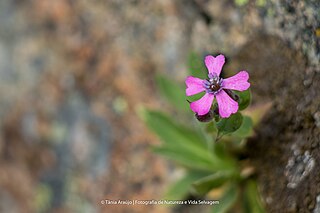
Silene acutifolia is a species of herb native to northwest Spain as well as central and northern Portugal. The species is polycarpic and usually grows in rocky environments.














